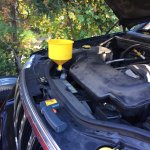Donald0039
Chief Petty Officer
- Joined
- Jun 11, 2022
- Messages
- 478
By saying the DTC was pretty much the same I mean the DTC was a 441 or 442 and the only data that was different from the prior tests was the engine coolant was 140F vs 86F in prev tests. I had the data on Diacom and brought my laptop home to figure a way to save the DTC in such a way that I could post it here. Unfortunately something went wrong and the DTC got deleted from Diacom.“The DTC was pretty much the same“
Do you mean like only one number off?
What did the four exhaust temp senders read?
But there were no exhaust risers temp readings in the DTC. I have never seen those in the DTC freeze frame data. However my IR temp gun showed the same temp for the exhaust manifold as in the DTC about 220F. But the exhaust risers temp was only 120F according to my IR temp gun.
From your description of the flow of the closed cooling system there is pretty much a straight path from the block to the exhaust manifolds. The block and the exhaust manifold should be roughly the same temperature. But the exhaust manifold was 220F and the engine coolant displayed was 140F.
Some air in the system still? How to bleed it?
I need to order more Volvo Penta VCS coolant!!




















